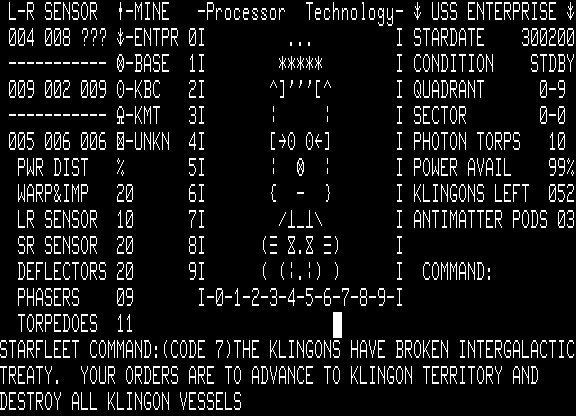This time, it was Dan's fault for asking on one of the TRS-80 groups if anyone had fond memories of Invasion Force, as he was re-coding it in some modern scripting language, or something like that. And if that wasn't dangling the carrot tantalisingly enough, he even posted a screen shot of his progress!
Invasion Force was a machine language 'real-time' version of the classic Star Trek games that was sold by Tandy for the TRS-80 Model I. Although in my opinion not as good as Time Trek, I did play it back in the day and do recall enjoying it.
 |
| Invasion Force on the TRS-80 Model I |
A bit of research yielded some surprising information; the game was first written for the SOL-20 microcomputer, and released as TREK 80. With the demise of the company Tandy somehow got hold of the source code, ported it to the TRS-80 Model I, and released it as Invasion Force.
 |
| The original SOL-20 version, TREK 80 |
Anyway, I decided to dig it out and, as any retro porter worth his salt would do, immediately start disassembling it. If nothing else I'd be able to provide Dan with some "inside information" should he ask.
In the end, it was a pretty straightforward task. It's not the most elegant or efficient Z80/TRS-80 code that I've ever seen either, but to be fair it was written in 1977. After completely reverse-engineering the TRS-80 version, I went back and named all the labels in the SOL-20 version. It's clear minimal changes were made to the code when porting to the TRS-80.
CORRECTION: It was, of course, 8080 code, rather than Z80.
When reverse-engineering the TRS-80 version I discovered two bugs.
The first bug has been ported from the SOL-20 version. Not worth the long-winded explanation but it's basically a table-lookup that extends beyond the table bounds during a delay routine when you run into a star - it's quite benign when all is said and done.
The second bug was introduced into the TRS-80 version. One of the experimental ray (random) outcomes is supposed to render all Jovian vessels in the quadrant invisible; instead it renders all Space Stations invisible. Because the SOL-20 and TRS-80 versions use different characters for their short-range scanner displays, the value(s) representing the Jovian vessels in the code had to change, and it was changed to the wrong value.
There are remnants of code in the TRS-80 version that isn't called that appears to be debug code. There's extra code - in the same spot - in the SOL-20 version that I haven't looked at yet. There are also some very minor tweaks to the TRS-80 version, some of which result in "dead code" from the original. And one hidden command not documented in the TRS-80 manual is the "L" command to leave the game, which jumps to the Level II BASIC entry point. Somewhat confusingly, the TRS-80 manual implies there is an "L" command for Long Range Sensors - so I expect people tried this and had the game subsequently 'crash'!?!
I now have a TRS-80 version that is fully relocatable, builds and runs. Someone suggested changing the directional controls (0-7) to more sensibly map those on the numeric keypad, which I might do. It's also tempting to convert the text to mixed-case, and fix the experimental ray bug.
And what about porting it to another platform? Aside from the Microbee, which could be done in a single afternoon, I doubt there'd be sufficient interest to warrant the effort. Every platform under the sun already has several Star Trek clones, and Invasion Force doesn't offer anything exceptional.
A fully-commented disassembly listing for the TRS-80, a fully-labelled listing for the SOL-20, plus the relocatable TRS-80 source, can be found on the Project List & Downloads page to the right.
UPDATE: I've added a few enhancements to the TRS-80 version, each of which can be individually enabled/disabled in the build. These comprise:
- ORG $5200 for compatibility with disk systems (source is fully relocatable)
- Mixed-case messages throughout the game
- Fixed the Experimental Ray bug that makes Space Stations invisible instead of Jovians that was introduced in the TRS-80 port (untested)
- Modified direction controls to map to more intuitive numeric keypad layout
Nicely done. If you do lower-case the strings, make sure a Model I without lowercase is still supported. I've tripped on that one a few times. Hint: "trs80gp -m1 -nlc invforce.cmd"
ReplyDeleteYou'll have to give me a tip on how that's done in practise. The current source may not readily lend itself to doing that very easily!?! In any case, I have a .define build option to include/exclude the mixed-case messages, so if someone really needs it, it can be built.
ReplyDeleteOn a completely unrelated note: the -m1 option combined with -na doesn't size the window correctly - the bottom few scanlines are cut off until you resize the window.
Ah. it's not accounting for the double-line menu bar because the window is so skinny. I'll figure that out. Thanks for the bug report.
ReplyDeleteI forget what disassembled game I found it in, but the simplest idea is to write to the screen, compare what you wrote and reset bit 5 if it wasn't equal. Something like:
print:
ld a,(de)
inc de
ld (hl),a
cp (hl)
jr z,ok
res 5,(hl)
ok:
inc hl
djnz print
ret
What's cool about that is that the program adapts dynamically to those machines which have a lower/upper case switch.
That may be hard to retrofit, in which case you could simply check that 'a' comes back as 'a' at program start and uppercase all your strings if not.